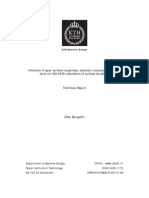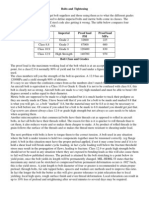Pages From MASTER - Publications-3
Pages From MASTER - Publications-3
Uploaded by
gioCopyright:
Available Formats
Pages From MASTER - Publications-3
Pages From MASTER - Publications-3
Uploaded by
gioOriginal Title
Copyright
Available Formats
Share this document
Did you find this document useful?
Is this content inappropriate?
Copyright:
Available Formats
Pages From MASTER - Publications-3
Pages From MASTER - Publications-3
Uploaded by
gioCopyright:
Available Formats
19FTM23.
New Standardized Calculation Method of the Tooth Flank Fracture Load Capacity of Bevel and
Hypoid Gears
Author: Josef Pellkofer, Michael Hein, Karsten Stahl, Tobias Reimann, and Ivan Boiadjiev
Bevel and hypoid gears are widespread in automotive, industrial, marine and aeronautical applications for
transmitting power between crossed axles. Future trends show that the demands on bevel and hypoid gears for
higher power transmission and lower weight are continuously increasing. A major aspect in the design process is
therefore the load carrying capacity regarding different failure modes. Beside typical fatigue failures like pitting and
tooth root breakage, which are the results of cracks initiated at or just below the surface, there are also failures
caused by cracks starting in greater material depth in the area of the active flank that can be observed on bevel
and hypoid gears. These cracks typically propagate to the tooth root area of the unloaded flank and to the surface
of the active flank. The failure mode known as tooth flank fracture occurs particularly frequently on large spiral
bevel and hypoid gears because this gear type shows larger equivalent radii of curvature compared to spur and
helical gears. As a result of the larger equivalent radius of curvature the maximum shear stress occurs in a larger
material depth, where the material of a case hardened gear shows a decreased strength. Important parameters
influencing the tooth flank fracture load capacity are geometry, operating conditions, material and heat treatment
of the gear set. Tooth flank fracture usually leads to the total breakdown of the gearbox and generally occurs
suddenly and unexpected since the crack initiation and propagation takes place below the tooth surface and
therefore cannot be identified within visual inspections.
This paper will give an overview of the subsurface failure mode known as tooth flank fracture on bevel and hypoid
gears. Further a newly developed standardized calculation method for determining the tooth flank fracture load
capacity based on the geometry of virtual cylindrical gear according to the standard ISO 10300 (2014) will be
explained in detail.
ISBN: 978-1-64353-062-8
19FTM24. Calculated Scuffing Risk: correlating AGMA 925-A03, AGMA 6011-J14 and Original MAAG Gear
Predictions
Author: John Amendola, Sr., John Amendola III, and Robert Errichello
Predicting scuffing risk is a critical factor when designing high speed gears. In years past, scuffing risk was not
calculated for gear tooth ratings for through hardened gears. Now, case hardened gears allow higher tooth loads
making it necessary to calculate scuffing risk. AGMA and ISO application standards rate only macropitting and
bending fatigue resistance. Both AGMA and ISO provide information sheets and technical specification reports,
but neither provides a specific design standard for assessing scuffing risk.
Scuffing is severe adhesive wear occurring on gear tooth flanks when oil film thickness is insufficient to prevent
transfer of metal from one gear tooth surface to the mating gear tooth due to welding and tearing. It usually occurs
during startup of new gears thereby requiring design modification, load adjustment, or lubricant change.
Nevertheless, it can occur after years of service if the oil deteriorates or load distribution across gear tooth flanks
changes.
This paper compares three methods for calculating scuffing risk using performance data for real gears and
presents a simplified method that assures accurate prediction of scuffing risk.
ISBN: 978-1-64353-063-5
19FTM25. Optimum Carburized and Hardened Case Depth
Author: Robert Errichello, and Andrew Milburn
The optimum carburized and hardened case depth for each gear failure mode is different and must be defined at
different locations on the gear tooth. Current gear rating standards do not fully explain the different failure modes
and do not clearly define the different locations that must be considered. Furthermore, they use different hardness
values to define effective case depth and provide different values for recommended case depth. This paper
explains why case hardening is beneficial; the risks involved and compares the methods for calculating and
specifying case depth per the ISO 6336-5 and ANSI/AGMA 2101-D04 gear rating standards, and guidelines
presented in the MAAG Gear Handbook. The paper shows the three locations that the case depth needs to be
specified and presents separate calculation methods to determine the optimum case depth to avoid the failure
modes of macropitting, subcase fatigue, bending fatigue, and case/core separation. For each failure mode there is
a minimum case depth below which the load capacity drops off. On the other hand, an excessively deep case
decreases load capacity, increases cost, and has other detrimental effects that are explained.
ISBN: 978-1-64353-064-2
Obsolete documents should not be used; please use replacements. Most obsolete and superseded documents are
available for purchase. Contact AGMA Headquarters for pricing and availability.
AGMA Publications Catalog 41 April 2020
You might also like
- Otraco Web Publications Maximising Tyre Life September 2002 PDFNo ratings yetOtraco Web Publications Maximising Tyre Life September 2002 PDF18 pages
- Agma Technical Paper-Calculated Scuffing Risk Correlating Agma 925-A03, Agma 6011-j14, and Original Maag Gear PredictionsNo ratings yetAgma Technical Paper-Calculated Scuffing Risk Correlating Agma 925-A03, Agma 6011-j14, and Original Maag Gear Predictions17 pages
- How to Supercharge & Turbocharge GM LS-Series Engines - Revised EditionFrom EverandHow to Supercharge & Turbocharge GM LS-Series Engines - Revised Edition5/5 (3)
- ANSI/AGMA 2009-B01. Reaffirmed March 2014.: ISBN: 1-55589-926-4 Pages: 23No ratings yetANSI/AGMA 2009-B01. Reaffirmed March 2014.: ISBN: 1-55589-926-4 Pages: 231 page
- 19FTM16. Material Properties and Tooth Root Bending Strength of Shot Blasted, Case Carburized Gears With Alternative MicrostructuresNo ratings yet19FTM16. Material Properties and Tooth Root Bending Strength of Shot Blasted, Case Carburized Gears With Alternative Microstructures1 page
- Influence of Gear Surface Roughness, Lubricant Viscosity and Quality Level On ISO 6336 Calculation of Surface DurabilityNo ratings yetInfluence of Gear Surface Roughness, Lubricant Viscosity and Quality Level On ISO 6336 Calculation of Surface Durability25 pages
- A Study On The Long-Term Performance Characteristics Conducted by The U.S. ArmyNo ratings yetA Study On The Long-Term Performance Characteristics Conducted by The U.S. Army9 pages
- Experience With Large, High-Speed Load Gears: Erwin Dehner and Francois WeberNo ratings yetExperience With Large, High-Speed Load Gears: Erwin Dehner and Francois Weber11 pages
- Fault Tree Analysis of Most Common Rolling BearingNo ratings yetFault Tree Analysis of Most Common Rolling Bearing11 pages
- Optimizing Gear Geometry For Minimum Transmission Error, Mesh Friction Losses and Scuffing Risk Through Computer - Aided EngineeringNo ratings yetOptimizing Gear Geometry For Minimum Transmission Error, Mesh Friction Losses and Scuffing Risk Through Computer - Aided Engineering10 pages
- ISBN: 1-55589-067-4 Pages: 16: AGMA Publications Catalog 52 April 2020No ratings yetISBN: 1-55589-067-4 Pages: 16: AGMA Publications Catalog 52 April 20201 page
- Tribology: Module6: Application of TribologyNo ratings yetTribology: Module6: Application of Tribology5 pages
- Hardened Ground Gears On System DesignsNo ratings yetHardened Ground Gears On System Designs19 pages
- 1.991201 - KC-DTE - Wheel Rail Friction Management Solution - Prorail99 - Paper2PRINT As Submitted - Rev 0No ratings yet1.991201 - KC-DTE - Wheel Rail Friction Management Solution - Prorail99 - Paper2PRINT As Submitted - Rev 06 pages
- Modern Pulley Design Techniques and Failure Analysis MethodsNo ratings yetModern Pulley Design Techniques and Failure Analysis Methods17 pages
- Troubleshooting Rolling Element Bearing ProblemsNo ratings yetTroubleshooting Rolling Element Bearing Problems24 pages
- Durability Assessment of Welded Structures Based On Welding Simulation With LS-DYNANo ratings yetDurability Assessment of Welded Structures Based On Welding Simulation With LS-DYNA13 pages
- PowerGen LifeExtension ForWebSite DRoberts 082807No ratings yetPowerGen LifeExtension ForWebSite DRoberts 08280721 pages
- Diesel Engine Failure Analysis - Brabon Engineering ServicesNo ratings yetDiesel Engine Failure Analysis - Brabon Engineering Services12 pages
- Fault Tree Analysis of Most Common Rolling Bearing Tribological FailuresNo ratings yetFault Tree Analysis of Most Common Rolling Bearing Tribological Failures11 pages
- Update On JHEP SAG Mill Drive SelectionNo ratings yetUpdate On JHEP SAG Mill Drive Selection20 pages
- Chapter D4: Shaft Deflection, Runout, Vibration, and Axial MotionNo ratings yetChapter D4: Shaft Deflection, Runout, Vibration, and Axial Motion21 pages
- How To Determine Bearing Shaft and Housing Fit - Baart GroupNo ratings yetHow To Determine Bearing Shaft and Housing Fit - Baart Group11 pages
- Get Back To Balance: Unbalanced Rotors Can Damage More Than Just BearingsNo ratings yetGet Back To Balance: Unbalanced Rotors Can Damage More Than Just Bearings2 pages
- Embeddability Behaviour of Tin-Based Bearing Material in Dry SlidingNo ratings yetEmbeddability Behaviour of Tin-Based Bearing Material in Dry Sliding7 pages
- Bearings And Bearing Metals: A Treatise Dealing with Various Types of Plain Bearings, the Compositions and Properties of Bearing Metals, Methods of Insuring Proper Lubrication, and Important Factors Governing the Design of Plain BearingsFrom EverandBearings And Bearing Metals: A Treatise Dealing with Various Types of Plain Bearings, the Compositions and Properties of Bearing Metals, Methods of Insuring Proper Lubrication, and Important Factors Governing the Design of Plain Bearings4/5 (1)
- ISBN: 1-55589-547-1 Pages: 15: AGMA Publications Catalog 48 April 2020No ratings yetISBN: 1-55589-547-1 Pages: 15: AGMA Publications Catalog 48 April 20201 page
- 2016 PAPERS: ISBN: 1-55589-060-5 Pages: 13No ratings yet2016 PAPERS: ISBN: 1-55589-060-5 Pages: 131 page
- 19FTM18. Influence of Manufacturing Variations of Spline Couplings On Gear Root and Contact StressNo ratings yet19FTM18. Influence of Manufacturing Variations of Spline Couplings On Gear Root and Contact Stress1 page
- 19FTM03. Spline Centering, Piloting, and Toggle: Torsional Stiffness, Shaft Bending, and Centering of Moment LoadsNo ratings yet19FTM03. Spline Centering, Piloting, and Toggle: Torsional Stiffness, Shaft Bending, and Centering of Moment Loads1 page
- 19FTM14. 4D High Pressure Gas Quenching - A Leap in Performance vs. Press QuenchingNo ratings yet19FTM14. 4D High Pressure Gas Quenching - A Leap in Performance vs. Press Quenching1 page
- 19FTM05. Design of A Double Spiral Bevel Gearset: ISBN: 978-1-64353-044-4No ratings yet19FTM05. Design of A Double Spiral Bevel Gearset: ISBN: 978-1-64353-044-41 page
- TR13989-1:2000 Calculation of Scuffing Load Capacity of Cylindrical, Bevel and Hypoid GearsNo ratings yetTR13989-1:2000 Calculation of Scuffing Load Capacity of Cylindrical, Bevel and Hypoid Gears1 page
- Unit-I Basic Concepts and First Law: ThermodynamicsNo ratings yetUnit-I Basic Concepts and First Law: Thermodynamics42 pages
- Stress Cracking Corrosion of Duplex Stainless Steel100% (1)Stress Cracking Corrosion of Duplex Stainless Steel288 pages
- Chapter 8 Bipolar Junction Transistors: Question: What Is The Meaning of "Bipolar" ?No ratings yetChapter 8 Bipolar Junction Transistors: Question: What Is The Meaning of "Bipolar" ?43 pages
- Structure of Crystalline Solids: Instructor: Prof. Sujoy Kumar KarNo ratings yetStructure of Crystalline Solids: Instructor: Prof. Sujoy Kumar Kar20 pages
- J 2003-ColdResgionsST Multi Surface Failure CriteriaNo ratings yetJ 2003-ColdResgionsST Multi Surface Failure Criteria25 pages
- Recent Developments in Polydopamine-Based Photocatalytic Nanocomposites For Energy Production - Physico-Chemical Properties and Perspectives 2021No ratings yetRecent Developments in Polydopamine-Based Photocatalytic Nanocomposites For Energy Production - Physico-Chemical Properties and Perspectives 202134 pages
- CE F311 Design of Concrete Structures: BITS PilaniNo ratings yetCE F311 Design of Concrete Structures: BITS Pilani50 pages
- Structural Analysis 7 Structural Analysis 7 Edition in SI Units Edition in SI UnitsNo ratings yetStructural Analysis 7 Structural Analysis 7 Edition in SI Units Edition in SI Units25 pages
- 61 MC Elvain Cave Durand Bingham Fluids HR ValueNo ratings yet61 MC Elvain Cave Durand Bingham Fluids HR Value10 pages
- Inorganic Halide Perovskite Solar Cells Progress ANo ratings yetInorganic Halide Perovskite Solar Cells Progress A28 pages
- ECS 213th ECS Meeting - Phoenix, AZ (May 18 - May 23, 2008) ) ECS Transactions - High Growth Rate SiO2 by Atomic Layer DepositionNo ratings yetECS 213th ECS Meeting - Phoenix, AZ (May 18 - May 23, 2008) ) ECS Transactions - High Growth Rate SiO2 by Atomic Layer Deposition5 pages








































































































